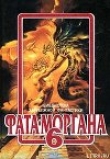
Текст книги "Психология оценки и принятия решений"
Автор книги: Скотт Плаус
Жанр:
Психология
сообщить о нарушении
Текущая страница: 16 (всего у книги 19 страниц)
in experimental social psychology(Vol. 6). New York: Academic Press. Ben Zur, H., Breznitz, S. J. (1981). The effects of time pressure on risky
choice behavior. Ada Psychologica, 47,89—104. Bernoulli, D. (1738/1954). Exposition of a new theory on the measurement
of risk, translated by Louise Sommer. Econometrica, 22,22—36. Beyth-Marom, M. (1982). Perception of correlation reexamined. Memory
Cognition, 10,511-519.
Bierbrauer, G. (1973). Effect of set, perspective, and temporal factors in attribution.Unpublished doctoral dissertation, Stanford University. Bishop, G.F., Oldendick, R. W., Tuchfarber, A. J., Bennett, S. E. (1980).
Pseudo-opinions on public affairs. Public Opinion Quarterly, 44,198—209. Blascovich, J., Ginsburg, G. P., Howe, R. С (1975). Blackjack and the
risky shift, II: Monetary stakes. Journal of Experimental Social Psychology,
11,224-232. Block, J. R., Yuker, H. E. (1989). Can you believe your eyes?New York:
Gardner Press.
Blodgett, R. (1983, November). Against all odds. Games,pp. 14—18. Bond, С F., Jr., Titus, L. J. (1983). Social facilitation: A meta-analysis of
241 studies. Psychological Bulletin, 94,265—292. Borgida, E., Nisbett, R. E. (1977). The differential impact of abstract vs.
concrete information on decisions. Journal of Applied Social Psychology, 7,
258-271.
326
Borrelli, S., Lockerbie, В., Niemi, R. G. (1987). Why the Democrat-Republican partisanship gap varies from poll to poll. Public Opinion Quarterly, 51,115-119.
Bostic, R., Herrnstein, R. J., Luce, R. D. (1990). The effect on the preference-reversal phenomenon of using choice indifferences. Journal of Economic Behavior and Organization, 13,193—212.
Bourne, L. E., Jr., Guy, D. E. (1968). Learning conceptual rules: II. The role of positive and negative instances. Journal of Experimental Psychology, 77,488-494. Bransford, J. D., Franks, J. J. (1971). The abstraction of linguistic ideas.
Cognitive Psychology, 2,331—350.
Brickman, P., Coates, D., Janoff-Bulman, R. (1978). Lottery winners and accident victims: Is happiness relative? Journal of Personality and Social Psychology, 36,917-927. Brockner, J., Rubin, J. Z. (1985). Entrapment in escalating conflicts:
A social psychological analysis.New York: Springer-Verlag. Brockner, J., Rubin, J. Z., Lang, E. (1981). Face-saving and entrapment.
Journal of Experimental Social Psychology, 17,68—79. Brockner, J., Shaw, M. C, Rubin, J. Z. (1979). Factors affecting withdrawal from an escalating conflict: Quitting before it's too late. Journal of Experimental Social Psychology, 15,492—503. Brophy, J. E. (1983). Research on the self-fulfilling prophecy and teacher
expectations. Journal of Educational Psychology, 75,631—661. Brown, E., Deffenbacher, K., Sturgill, W. (1977). Memory for faces and the circumstances of encounter. Journal of Applied Psychology, 62,311—318. Bruner, J. S., Postman, L. J. (1949). On the perception of incongruity:
A paradigm. Journal of Personality, 18,206—223. Budiansky, S. (1988), July 11). The numbers racket: How polls and statistics
lie. U.S. News World Report,pp. 44—47.
Campbell, J. D., Tesser, A. (1983). Motivational interpretations of hindsight bias: An individual difference analysis. Journal of Personality, 51,605-620. Cantril, H. (1940). Experiments in the wording of questions. Public Opinion
Quarterly, 4,330-332. Carden, G. (1990, September 25). Strangers, but they share unbelievable
mirror-image lives. National Enquirer,p. 19.
Carroll, J. S. (1978). The effect of imagining an event on expectations for the event: An interpretation in terms of the availability heuristic. Journal of Experimental Social Psychology, 14,88—96.
Centor, R. M., Dalton, H. P., Yates, J. F. (1984). Are physicians'probability estimates better or worse than regression model estimates?Paper presented at the Sixth Annual Meeting of the Society for Medical Decision Making, Bethesda, MD.
327
Cervone, D., Peake, P. K. (1986). Anchoring, efficacy, and action: The influence of judgmental heuristics on self-efficacy judgments. Journal of Personality and Social Psychology, 50,492—501.
Chandler, T. A., Shama, D. D., Wolf, F. M., Planchard, S. K. (1981). Multiattributional causality: A five cross-national samples study. Journal of Cross-Cultural Psychology, 12,207-221. Chapman, L. J. (1967). Illusory correlation in observational report. Journal
of Verbal Learning and Behavior, 6,151—155.
Chapman, L. J., Chapman, J. P. (1967). Genesis of popular but erroneous psychodiagnostic observations. Journal of Abnormal Psychology, 72,193—204. Chapman, L. J., Chapman, J. P. (1969). Illusory correlation as an obstacle to the use of valid psychodiagnostic signs. Journal of Abnormal Psychology, 74,271-280.
Chapman, L. J., Chapman, J. P. (1971, November). Test results are what you think they are. Psychology Today,pp. 18—22, 106—110.
Cheng, P. W., Novick, L. R. (1990). A probabilistic contrast model of causal induction. Journal of Personality and Social Psychology, 58,545—567.
Christensen, D., Rosenthal, R. (1982). Gender and nonverbal decoding skill as determinants of interpersonal expectancy effects. Journal of Personality and Social Psychology, 42,75—87.
Christensen-Szalanski, J. J. J., Beach, L. R. (1984). The citation bias: Fad and fashion in the judgment and decision literature. American Psychologist, 39,75-78.
Christensen-Szalanski, J. J. J., Beck, D. E., Christensen-Szalanski, С. М., Koepsell, T. D. (1983). Effects of expertise and experience on risk judgments. Journal of Applied Psychology, 68,278—284.
Christensen-Szalanski, J. J. J., Bushyhead, J. B. (1981). Physicians' use of probabilistic information in a real clinical setting. Journal of Experimental Psychology: Human Perception and Performance, 7,928—935.
Christensen-Szalanski, J. J. J., Willham, C. F. (1991). The hindsight bias: A meta-analysis. Organizational Behavior and Human Decision Processes, 48,147-168.
Clifford, B. R., Scott, J. (1978). Individual and situational factors in eyewitness testimony. Journal of Applied Psychology, 63,352—359.
Clymer, A. (1982, May 6). Nuclear issue yields run on pollsters. New York Times,p. В14.
Cohen, B. L., Lee, I. (1979). A catalog of risks. Health Physics, 36,707-722.
Cohen, J., Chesnick, E. I., Haran, D. (1971). Evaluation of compound probabilities in sequential choice. Nature, 232,414—416.
Combs, В., Slovic, P. (1979). Newspaper coverage of causes of death. Journalism Quarterly, 56,837—843, 849.
Converse, P. E., Schuman, H. (1970, June). "Silent majorities" and the Vietnam war. Scientific American,pp. 17—25.
328
Coombs, С. Н. (1975). Portfolio theory and the measurement of risk. In M. F. Kaplan S. Schwartz (Eds.), Human judgment and decision processes.New York: Academic Press.
Cooper, W. H. (1981). Ubiquitous halo. Psychological Bulletin, 90,218—244.
Coren, S., Miller, J. (1974). Size contrast as a function of figural similarity. Perception and Psychophysics, 16,355—357.
Corey, S. M. (1937). Professed attitudes and actual behavior. Journal of Educational Psychology, 28,271—280.
Costanza, R. (1984). Review essay: The nuclear arms race and the theory ofsocial traps. Journal of Peace Research, 21,79—86.
Craig, K. D., Prkachin, К. М. (1978). Social modeling influences on sensory decision theory and psychophysiological indexes of pain. Journal of Personality and Social Psychology, 36,805—815.
Crandall, V. J., Solomon, D., Kellaway, R. (1955). Expectancy statements and decision times as functions of objective probabilities and reinforcement values. Journal of Personality, 24,192—203.
Crocker, J. (1981). Judgment of covariation by social perceivers. Psychological Bulletin, 90,272-292.
Crocker, L. (1982). Biased questions in judgment of covariation studies. Personality and Social Psychology Bulletin, 8,214—220.
Cross, J. G., Guyer, M. J. (1980). Social traps.Ann Arbor: University of Michigan Press.
Darley, J. M., Batson, С D. (1973). "From Jerusalem to Jericho": A study of situational and dispositional variables in helping behavior. Journal of Personality and Social Psychology, 27,100—108.
Darley, J. M., Fazio, R. H. (1980). Expectancy confirmation processes arising in the social interaction sequence. American Psychologist, 35,867—881.
Darley, J. M., Latane, B. (1968). Bystander intervention in emergencies; Diffusion of responsibility. Journal of Personality and Social Psychology, 8,377-383.
Davis, J. H. (1973). Group decision and social interaction: A theory ofsocial decision schemes. Psychological Review, 80,97—125.
Dawes, R. M. (1975). The mind, the model, and the task. In F. Restle, R. M. Shiffrin, N. J. Castellan, H. R. Lindman, D. B. Pisoni (Eds.), Cognitive theory(Vol. 1). Hillsdate, NJ: Erlbaum.
Dawes, R. M. (1980). Social dilemmas. Annual Review of Psychology, 31,169-193.
Dawes, R. M., Faust, D., Meehl, P. E. (1989). Clinical versus actuarial judgment. Science, 243,1688—1674.
"Death Odds". (1990, September 24). Newsweek,p. 10.
Deci, E. L. (1975). Intrinic motivation.New York: Plenum Press.
Deffenbacher, K. A. (1980). Eyewitness accuracy and confidence. Law and Human Behavior, 4,243—260.
329
Diener, D., Thompson, W. B. (1985). Recognizing randomness. American Journal of Psychology, 98,433—447.
Dion, K., Berscheid, E., Walster, E. (1972). What is beautiful is good. Journal of Personality and Social Psychology, 24,285—290.
Doob, A. N., Carlsmith, J. M., Freedman, J. L., Landauer, Т. К., Tom, S., Jr. (1969). Effect of initial selling price on subsequent sales. Journal of Personality and Social Psychology, 11,345—350.
Dube-Rioux, L., Russo, J. E. (1988). An availability bias in professional judgment. Journal of Behavioral Decision Making, 1,223—237.
Duncan, B. L. (1976). Differential social perception and attribution of inter-group violence: Testing the lower limits of stereotyping blacks. Journal of Personality and Social Psychology, 43,590—598.
Dunning, D., Griffin, D. W., Milojkovic, J. D., Ross, L. (1990). The overconfidence effect in social prediction. Journal of Personality and Social Psychology, 58,568-581.
Dunning, D., Parpal, M. (1989). Mental addition versus subtraction in counterfactual reasoning: On assessing the impact of personal actions and life events. Journal of Personality and Social Psychology, 57,5—15.
Duval, S., Wicklund, S. A. (1973). Effects of objective self-awareness on attribution of causality. Journal of Experimental Social Psychology, 9,17—31.
Ebbesen, E. В., Konecni, V. J. (1975). Decision making and information integration in the courts: The setting of bail. Journal of Personality and Social Psychology, 32,805-821.
Edeal, G. H. (1950, March 27). Why the choir was late. Life,p. 19.
Eddy, D. (1982). Probabilistic reasoning in clinical medicine: Problems and opportunities. In D. Kahneman, P. Slovic, A. Tversky (Eds.), Judgment under uncertainty: Heuristics and biases.Cambridge, England: Cambridge University Press.
Edwards, W. (1968). Conservatism in human information processing. In B. Kleinmuntz (Ed.), Formal representation of human judgment.New York: John Wiley and Sons.
Einhorn, H. J., Hogarth, R. M. (1981). Behavioral decision theory: Processes of judgment and choice. Annual Review of Psychology, 32,53—88.
Einhorn, H. J., Hogarth, R. J. (1986). Backward and forward thinking in decision making. Selected Paper No. 62.Chicago: Graduate School of Business, University of Chicago.
Ellsberg, D. (1961). Risk, ambiguity, and the Savage axioms. Quarterly Journal of Economics, 75,643—669.
Esser, J. K., Lindoerfer, J. S. (1989). Groupthink and the space shuttle Challenger accident: Toward a quantitative case analysis. Journal of Behavioral Decision Making, 2,167—177.
Fama, E. F. (1965). Random walks in stock market prices. Financial Analysts Journal, 21,55-60.
330
Feldman, J. M. (1986). A note on the statistical correction of halo error. Journal of Applied Psychology, 71,173—176.
Feldman, R. S., Prohaska, T. (1979). The student as Pygmalion: Effect of student expectation on the teacher. Journal of Educational Psychology, 71485-493.
Feldman, R. S., Theiss, A. J. (1982). The Teacher and the student as Pygmalions: Joint effects of teacher and student expectations. Journal of Educational Psychology, 74,217—223.
Festinger, L. (1954). A theory of social comparison processes. Human Relations, 7,117-140.
Festinger, L. (1957). A theory of cognitive dissonance.Evanston, IL: Row, Peterson.
Festinger, L., Carlsmith, J. M. (1959). Cognitive consequences of forced compliance. Journal of Abnormal and Social Psychology, 58,203—210.
Feynman, R. P. (1988, February). An outsider's inside view of the Challenger inquiry. Physics Today,26—37.
Fiedler, K. (1988). The dependence of the conjunction fallacy on subtle linguistic factors. Psychological Research, 50,123—129.
Fischhoff, B. (1977). Perceived informativeness of facts. Journal of Experimental Psychology: Human Perception and Performance, 3,349—358.
Fischhoff, B. (1991). Value elicitation: Is there anything in there? American Psychologist, 46,835-847.
Fischhoff, В., Bar-Hillel, M. (1984). Diagnosticity and the base-rate effect. Memory Cognition, 12,402—410.
Fischhoff, В., Beyth, R. (1975). "I Knew it would happen": Remembered probabilities of once-future things. Organizational Behavior and Human Performance, 13,1—16.
Fischhoff, В., Beyth-Marom, R. (1983). Hipothesis evaluation from a Bayesian perspective. Psychological Review, 90,239—260.
Fischhoff, В., Lichtenstein, S., Slovic, P., Derby, S. L., Keeney, R. L. (1981). Acceptable risk.Cambridge, England: Cambridge University Press.
Fischhoff, В., Slovic, P. (1980). A little learning...: Confidence in multi-cue judgment tasks. In R. Nickerson (Ed.), Attention and performance, VIII.Hillsdale, NJ: Erlbaum.
Fischhoff, В., Slovic, P., Lichtenstein, S. (1977). Knowing with certainty: The appropriateness of extreme confidence. Journal of Experimental Psychology: Human Perception and Performance, 3,552—564.
Fishburn, P. С (1984). SSB utility theory and decision making under uncertainty. Mathematical Social Sciences, 8,253—285.
Fiske, S. Т., Taylor, S. E. (1991). Social cognition(2nd ed). New York: McGraw-Hill.
Fletcher, D. J. O., Ward, W. (1988). Attribution theory and processes: A cross-cultural perspective. In M. H. Bond (Ed.), The cross-cultural challenge to social psychology.Newbury Park, CA: Sage Publications.
331
Forsterling, F. (1989). Models of covariation and attribution: How do they relate to the analogy of analysis of variance? Journal of Personality and Social Psychology, 57,615—625.
Frenkel, O. J., Doob, A. N. (1976). Post-decision dissonance at the polling booth. Canadian Journal of Behavioral Science, 8,347—350.
Frieze, I. H., Bar-Tal, D., Carroll, J. S. (Eds.). New approaches to social problems.San Francisco: Jossey-Bass.
Galper, R. E. (1976). Turning observers into actors: Differential causal attributions as a function of "empathy". Journal of Research in Personality, 10,328-335.
Gansberg, M. (1964, March 27). 37 who saw murder didn't call the police. New York Times,pp. 1, 38.
Gill, S. (1947, March 14). How do you stand on sin? Tide,p. 72.
Gilovich, Т., Vallone, R., Tversky, A. (1985). The hot hand in basketball: On the misperception of random sequences. Journal of Personality and Social Psychology, 17,295-314.
Gliksman, A. (1986, February 13). Behind Moscow's fear of "Star Wars". New York Times,p. 27.
Gmelch, G. (1978, August). Baseball magic. Human Nature,pp. 32—39.
Goldberg, L. R. (1959). The effectiveness of clinicians'judgments: The diagnosis of organic brain damage from the Bender-Gestalt test. Journal of Consulting Psychology, 23,25—33.
Golding, S. L., Rorer, L. G. (1972). Illusory correlation and subjective judgment. Journal of Personality and Social Psychology, 80,249—260.
Graham, T. W., Kramer, В. М. (1986). The polls: ABM and Star Wars: Attitudes toward nuclear defense, 1945—1985. Public Opinion Quarterly, 50,125-134.
Greenberg, J., Williams, K. D., O'Brien, M. K. (1986). Considering the harshest verdict first: Biasing effects on mock juror verdicts. Personality and Social Psychology Bulletin, 12,41—50.
Gregory, W. L., Cialdini, R. В., Carpenter, К. В. (1982). Self-relevant scenarios as mediators of likelihood and compliance: Does imagining make it so? Journal of Personality and Social Psychology, 43,89—99.
Grether, D. M., Plott, C. R. (1979). Economic theory of choice and the preference reversal phenomenon. American Economic Review, 69,623—638.
Griffin, D. W., Dunning, D., Ross, L. (1990). The role of construal processes in overconfident predictions about the self and others. Journal of Personality and Social Psychology, 59,1128—1139.
Griggs, R. A., Cox, J. R. (1982). The elusive thematic-materials effect in Wason's selection task. British Journal of Psychology, 73,407—420.
Gross, E. J. (1964). The effect of question sequence on measures of buying interest. Journal of Advertising Research, 4,40—41.
Haberman, C. (1990, July 19). A child's nightmare in Italy is now the nation's shame. New York Times,pp. Al, All.
332
Hagafors, R., Brehmer, B. (1983). Does having to justify one's judgments change the nature of the judgment process? Organizational Behavior and Human Performance, 31,223—232.
Hake, H. W., Hyman, R. (1953). Perception of the statistical structure of a random series of binary symbols. Journal of Experimental Psychology, 45,64-74.
Hamilton, D. L., Rose, T. L. (1980). Illusory correlation and the maintenance of stereotypic beliefs. Journal of Personality and Social Psychology, 39,832-845.
Hardin, G. (1968). The tragedy of the commons. Science, 162,1243—1248. «Harper's Index». (1986, October). Harper's,p. 11.
Harris, R. J. (1973). Answering questions containing marked and unmarked adjectives and adverbs. Journal of Experimental Psychology, 97,399—401.
Hartley, E. (1946). Problems in prejudice.New York: King's Crown Press.
Harvey, J. H., Town, J. P., Yarkin, K. L. (1981). How fundamental is the "fundamental attribution error"? Journal of Personality and Social Psychology, 40,346—349.
Hastie, R. (1986). Review essay: Experimental evidence on group accuracy. In B. Grofman and G. Owen (Eds.), Information pooling and group decision making: Proceedings of the Second University of California, Irvine, Conference on Political Economy.Greenwich, CT: Jai Press.
Hastorf, A. H., Cantril, H. (1954). They saw a game: A case study. Journal of Abnormal and Social Psychology, 49,129—134.
Hawkins, S. A., Hastie, R. (1990). Hindsight: Biased judgments of past events after the outcomes are known. Psychological Bulletin, 107,311—327.
Heider, F. (1958). The psychology of interpersonal relations.New York: Wiley.
Henchy, Т., Glass, D. C. (1968). Evaluation apprehension and the social facilitation of dominant and subordinate responses. Journal of Personality and Social Psychology, 10,446—454.
Henslin, J. M. (1967). Graps and magic. American Journal of Sociology, 73,316-330.
Hershey, J. C, Schoemaker, P. J. H. (1980). Risk taking and problem context in the domain of losses: An expected utility analysis. Journal of Risk and Insurance, 47,111—132.
Hewstone, M. R. C, Jaspars, J. M. F. (1987). Covariation and causal attribution: A logical model for the intuitive analysis of variance. Journal of Personality and Social Psychology, 53,663—672.
Hill, G. W. (1982). Group versus individual performance: Are N + Iheads better than one? Psychological Bulletin, 91,517—539.
Hilton, D. J., Slugoski, B. R. (1986). Knowledge-based causal attribution: The abnormal conditions focus model. Psychological Review, 93,75—88.
Hilts, P. J. (1990, September 26). Major gains are cited for smokers who quit. New York Times,p. B4.
333
Hintzman, D. L. (1969). Apparent frequency as a function of frequency and the sparing of repetitions. Journal of Experimental Psychology, 80,139—145.
Hippler, H., Schwarz, N. (1986). Not forbidding isn't allowing: The cognitive basis of the forbid-allow asymmetry. Public Opinion Quarterly, 50,87-96.
Hoch, S. J. (1984). Availability and interference in predictive judgment. Journal of Experimental Psychology: Learning, Memory, and Cognition, 10,
649-662. Hoch, S. J. (1985). Counterfactual reasoning and accuracy in predicting
personal events. Journal of Experimental Psychology: Learning, Memory,
and Cognition, 11,719-731. Hofstadter, D. R. (1985). Metamagical themas: Questing for the essence of
mind and pattern.New York: Basic Books. Hogarth, R. M. (1975). Cognitive processes and the assessment of subjective
probability distributions. Journal of American Statistical Association, 70,
Hogarth, R. (1987). Judgment and choice (2nd ed.).New York: John Wiley and Sons.
Hooke, R. (1983). How to tell the liars from the statisticians.New York: Marcel Dekker.
Hornstein, H. A., Fisch, E., Holmes, M. (1968). Influence of a model's feeling about his behavior and his relevance as a comparison other on observers' helping behavior. Journal of Personality and Social Psychology, 10,222-226.
Hunter I M. L., (1964). Memory.Middlesex, England: Penguin Books.
Ingham, A. G., Levinger, G., Graves, J., Peckham, V. (1974). The Ringel-mann effect: Studies of group size and group performance. Journal of Experimental Social Psychology, 10,371—384.
Irwin, F. W. (1953). Stated expectations as functions of probability and desirability of outcomes. Journal of Personality, 21,329—335.
Irwin, F. W., Metzger, J. (1966). Effects of probabilistic independent outcomes upon predictions. Psychonomic Science, 5,79—80.
Irwin, F. W., Snodgrass, J. G. (1966). Effects of independent and dependent outcome values upon bets. Journal of Experimental Psychology, 71,282-285.
Isen, A. M., Daubman, K. A., Nowicki, G. P. (1987). Positive affect facilitates creative problem solving. Journal of Personality and Social Psychology, 52,1122-1131.
Isen, A. M., Geva, N (1987). The influence of positive affect on acceptable level of risk: The person with a large canoe has a large worry. Organizational Behavior and Human Decision Processes, 39,145—154.
Isen, A. M., Patrick, R. (1983). The effect of positive feelings on risk taking: When the chips are down. Organizational Behavior and Human Performance, 31,194-202.
334
Ives, G. (1970). A history of penal methods: Criminals, witches, lunatics.
Montclair, NJ: Patterson Smith. Janis, I. L. (1982). Groupthink: Psychological studies of policy decisions and
fiascoes(2nd ed.). Boston: Houghton Mifflin.
Jenkins, H. M., Ward, W. C. (1965). The judgment of contingency between responses and outcomes. Psychological Monographs, 79,(Whole No. 594). Jenkins, J. J.(1981). Can we have a fruitful cogninive psychology? In J. H. Flowers (Ed.). Nebraska symposium on motivation, 1980.Lincoln: University of Nebraska Press.
Jennings, D. L., Amabile, T. V., Ross, L. (1982). Informal covariation assessment: Data-based versus theory based judgments. In D. Kahneman, P. Slovic, A. Tversky (Eds.), Judgment under uncertainty: Heuristics and biases.Cambridge, England: Cambridge University Press.
Johnson, E. J., Tversky, A. (1983). Affect, generalization, and the perception of risk. Journal of Personality and Social Psychology, 45,20—31.
Jones, E. E. (1979). The rocky road from acts to dispositions. American Psychologist, 34,107—117.
Jones, E. E., Davis, К. Е. (1965). From acts to dispositions: The attribution process in person perception. In L. Berkowitz (Ed.), Advances in experimental social psychology(Vol. 2, pp. 219—266). New York: Academic Press.
Jones, E. E., Harris, V. A. (1967). The attribution of attitudes. Journal of Experimental Social Psychology, 3,1—24.
Jones, E. E., Nisbett, R. E. (1971). The actor and the observer: Divergent perceptions of the causes of behavior. In E. E. Jones et al. (Eds.), Attribution: Perceiving the causes of behavior.Morristown, NJ: General Learning Press.
Jones, E. E., Wood, G. C, Quattrone, G. A. (1981). Perceived variability of personal characteristics in in-groups and out-groubs: The role of knowledge and evaluation. Personality and Social Psychology Bulletin, 7,523—528.
Jones, R. T. (1971). Tetrahydrocannabinol and the marijuana-induced social "high", or the effects of the mind on marijuana. Annals of the New York Academy of Sciences, 191,155—165.
Jussim, L. (1986). Self-fulfilling prophecies: A theoretical and integrative review. Psychological Review, 93,429—445.
Kahneman, D. (1991). Judgment and decision making: A personal view. Psychological Science, 2,142—145.
Kahneman, D., Knetsch, J, L., Thaler, R. H. (1990). Experimental tests of the endowment effect and the Coase theorem. Journal of Political Economy, 98,1325-1348.
Kahneman, D., Tversky, A. (1972). Subjective probability: A judgment of representativeness. Cognitive Psychology, 3,430—454.
Kahneman, D., Tversky, A. (1973). On the psychology of prediction. Psychological Review, 80,237—251.
335
Kahneman, D., Tversky, A. (1979). Prospect theory: An analysis of decision under risk. Econometrica, 47,263—291.
Kammer, D. (1982). Differences in trait ascriptions to self and friend: Un-confounding intensity from variability. Psychological Reports, 51,99—102.
Kantola, S. J., Syme, G. J., Campbell, N. A. (1984). Cognitive dissonance and energy conservation. Journal of Applied Psychology, 69,416—421.
Karmarkar, U. (1978). Subjectively weighted utility: A descriptive extension of the expected utility model. Organizational Behavior and Human Performance, 21,61—72.
Kassin, S. M. (1979). Consensus information, prediction, and causal attribution: A review of the literature and issues. Journal of Personality and Social Psychology, 37,1966-1981.
Kelley, H. H. (1950). The warm-cold variable in first impressions of persons. Journal of Personality, 18,431—439.
Kelley, H. H. (1967). Attribution theory in social psychology. In D. Levine (Ed.), Nebraska symposium on motivation, 1967.Lincoln: University of Nebraska Press.
Kelley, H. H. (1973). The processes of causal attribution. American Psychologist, 28,107-128.
Kelley, H. H., Michela, J. L. (1980). Attribution theory and research. Annual Review of Psychology, 31,457—501.
Keren, G. (1987). Facing uncertainty in the game of bridge: A calibration study. Organizational Behavior and Human Decision Processes, 39,98—114.
Klayman, J., Ha, Y. (1987). Confirmation, disconfirmation, and information in hypothesis testing. Psychological Review, 94,211—228.
Kleinmuntz, D. N. (1985). Cognitive heuristics and feedback in a dynamic decision environment. Management Science, 31,680—702.
Knetsch, J. L., Sinden, J. A. (1984). Willingness to pay and compensation demanded: Experimental evidence of an unexpected disparity in measures of value. Quarterly Journal of Economics, 99,507—521.
Knox, R. E., Inkster, J. A. (1968). Postdecision dissonance at post time. Journal of Personality and Social Psychology, 8,319—323.
Kogan, N., Wallach, M. A. (1964). Risk taking: A study in cognition and personality.New York: Holt, Rinehart and Winston.
Koriat, A., Lichtenstein, S., Fischhoff, B. (1980). Reasons for confidence. Journal of Experimental Psychology: Human Learning and Memory, 6,107—118.
Kristiansen, С. М. (1983). Newspaper coverage of diseases and actual mortality statistics. European Journal of Social Psychology,13, 193—194.
Lamal, P. A. (1979, October). College student common beliefs about psychology. Teaching og Psychology,pp. 155—158.
Landy, D., Sigall, H. (1974). Beauty is talent: Task evaluation as a function of the performer's physical attractiveness. Journal of Personality and Social Psychology, 29,299-304.
336
Langer, E. J. (1975). The illusion of control. Journal of Personality and Social Psychology, 32,311-328.
Langer, E. J., Rodin, J. (1976). The effects of choice and enhanced personal responsibility for the aged: A Field experiment in an institutional setting. Journal of Personality and Social Psychology', 34,191—198. Langer, E. J., Roth, J. (1975). Heads I win, tails it's chance: The illusion of control as a function of the sequence of outcomes in a purely chance task. Journal of Personality and Social Psychology, 32,951—955. La Piere, R. T. (1934). Attitudes vs. actions. Social Forces, 13,230—237. Lasky, J. J., Hover, G. L., Smith, P. A., Bostian, D. W., Duffendack, S. C, Nord, C. L. (1959). Post-hospital adjustment as predicted by psychiatric patients and by their staff. Journal of Consulting Psychology, 23,213—218. Latane, В., Dabbs, J. M., Jr. (1975). Sex, group size and helping in three
cities. Sociometry, 38,180—194. Latane, В., Darley, J. M. (1969). Bystander «apathy». American Scientist,
57,244-268. Latane, В., Darley, J. M. (1970). The unresponsive bystander: Why doesn't
he help?Englewood Cliffs, NJ: Prentice-Hall. Latane, В., Nida, S. (1981). Ten years of research on group size and
helping. Psychological Bulletin, 89,308—324.
Latane, В., Williams, K., Harkins, S. (1979). Many hands make light the work: The causes and consequences of social loafing. Journal of Personality and Social Psychology, 37,822—832.
Latane, В., Wolf, S. (1981). The social impact of majorities and minorities. Psychological Review, 88,438—453. Leary, M. R. (1981). The distorted nature of hindsight. Journal of Social
Psychology, 115,25—29. Leary, M. R. (1982). Hindsight distortion and the 1980 presidential election.
Personality and Social Psychology Bulletin, 8,257—263. Leddo, J., Abelson, R. P., Gross, P. H. (1984). Conjunctive explanations: When two reasons are better Than one. Journal of Personality and Social Psychology, 47,933—943.
Lefcourt, H. M. (1982). Locus of control: Current trends in theory and research.Hillsdale, NJ: Erlbaum.
Leippe, M. R., Wells, G. L., Ostrom, Т. М. (1978). Crime seriousness as a determinant of accuracy in eyewitness identification. Journal of Applied Psychology, 63,345-351. Lelyveld, J. (1986, October 5). Britainheads for nuclear war at polls. New
York Times,p. E2.
Levi, A. S., Pryor, J. B. (1987). Use of the availability heuristic in probability estimates of future events: The effects of imagining outcomes versus imagining reasons. Organizational Behavior and Human Decision Processes, 40,219-234.
337
Lichtenstein, S., Fischhoff, B. (1977). Do those who know more also know more about how much they know? Organizational Behavior and Human Performance, 20,159—183. Lichtenstein, S., Fischhoff, B. (1980). Training for calibration.








